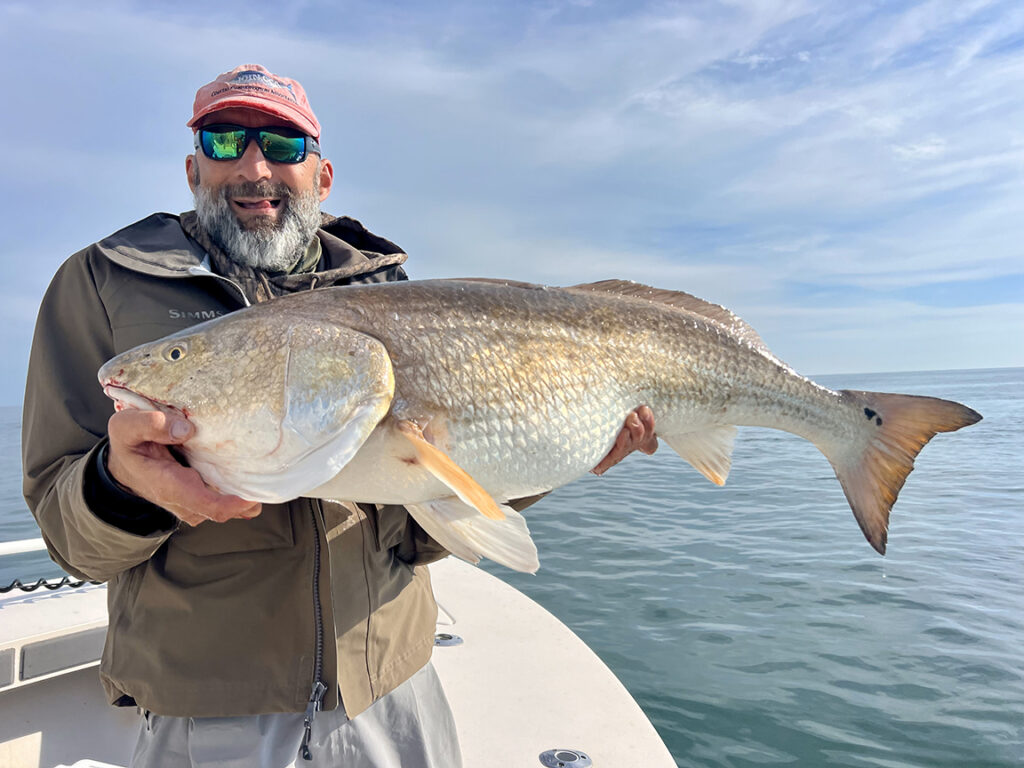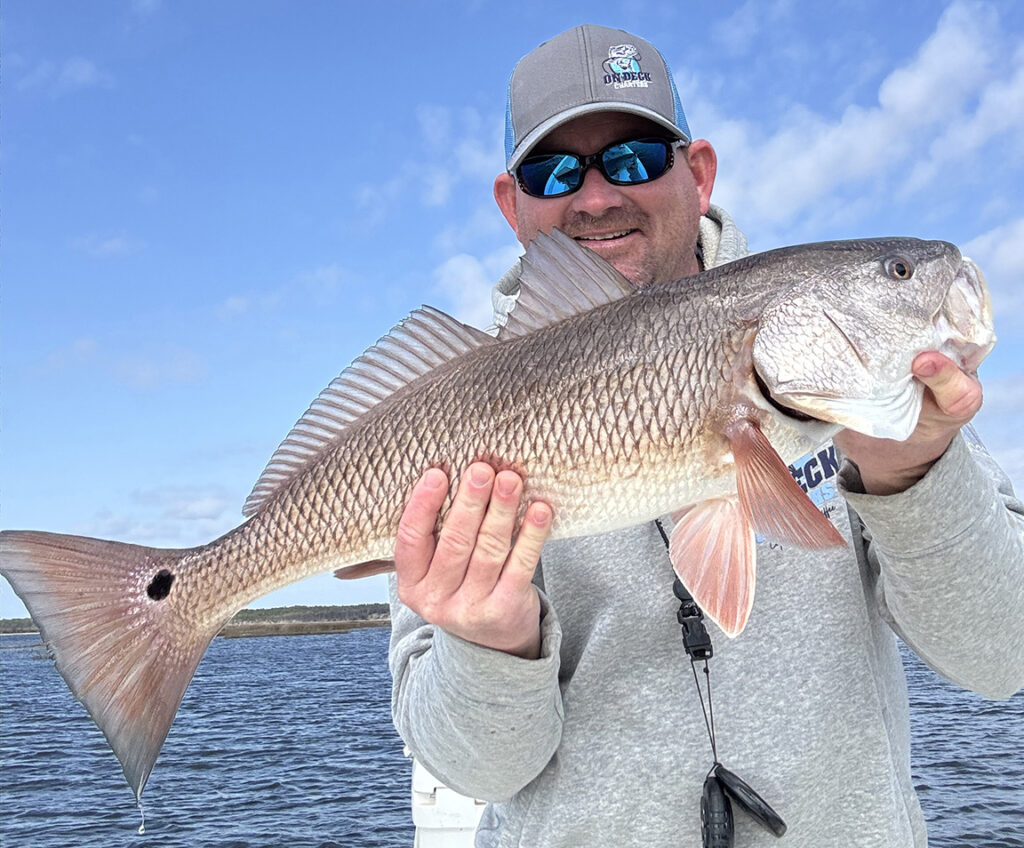Morehead/Atlantic Beach – March 2025
Matt, of Chasin’ Tails, reports that anglers targeting red drum have found some good action around the Shark Island area.
Speckled trout are still biting, though the cooler water temperatures have them lethargic and tucked back into their wintering holes.
Anglers running out to the Cape Lookout jetty have been finding black drum and sheepshead.
Those catching a weather window and choosing to run offshore are having modest success targeting wahoo out in the Gulf Stream.
Bluefin tuna are still hanging around and not too far off the beaches.
Joe, of Carolina Traditions Guide Co., reports that red drum have remained in the same winter areas with little movement since the last cold snap. When the area enjoys pretty days between fronts, get out and target these fish on the flats or around the darker, muddy bottoms that help bring those water temperatures up. Be very stealthy, as these fish are lethargic and spooky.
Anglers can also find some flounder around when targeting backwater holes for reds.
Speckled trout are around to catch and release when you can locate them in their back creek wintering areas. Many times, a smaller jig works best when scouting out these schools. Once found, throwing larger jigs helps get the quality ones to strike.
Cut shrimp will produce some black drum when dropped down around the deeper structures, docks (3-4’ water depths), oyster rocks, and rock jetties.
Nearshore anglers are focused on the solid black sea bass bite in the 60-80’ range. Occasionally, tautogs are mixed in alongside them.

Pete, of Columbia, landed this 48″ old drum offshore of Atlantic Beach in 30′ of water using a bucktail jig. He was fishing with Capt. Chris Kimrey of Mount Maker Charters.
Daniel, of On Deck Fishing Charters, reports that anglers have had some success targeting black drum and sheepshead both around structure inside and out around the Cape Lookout jetty.
If the weather is cooperating, you can also look for the larger schools of red drum that are moving around in the shallow bays.
Moving into March, anglers look forward to nearshore water temperatures starting to rise and the arrival of gray trout over the nearshore ARs, joining the black sea bass that are already there.
Deeper holes around the inlet and Port wall also see schools of sea mullet start to move in, with gray trout mixed around the sea mullet as well.
Chris, of Mount Maker Charters, reports that inshore anglers are finding some black drum and sheepshead.
Off the beach, anglers targeting nearshore structures can find good black sea bass action, with larger gray trout also joining them.
Anglers running offshore are still able to find bluefin tuna in the area.
Justin, of Breakday Charters, reports that moving into March, one of the first species to arrive are sea mullet, which show almost all at once in the surf, deeper holes in the inlet, and up into the Port area. Some double hook spec rigs and fresh cut shrimp will do the trick.
Red drum have been schooled up and holding pretty shallow, and warming water temperatures will only get them more active. A few speckled trout are also around.
The first schools of bluefish typically show up in March both nearshore and around the inlet, and nearshore bottoms will start to see gray trout moving in by the end of the month.
Anglers running out to target structure in the 60-90’ range can have success with a bigger class of black sea bass. Pushing deeper (out to 100-120’) also gets into some vermilion snapper and other bottom species.
Offshore, the area is just starting to see the first signs of wahoo fishing picking up, and blackfin tuna will be mixed in.

Capt. Daniel Griffiee, of Chasin’ Tails Outdoors, landed this 26″ red drum in the Haystacks using a pink Billy Bay 1/4 oz. soft plastic shrimp.
Lee, of Top Gun Fishing, reports that anglers have been finding sheepshead and black drum around some of the deeper structures inside. With the cold-water temperatures, cut shrimp has been the top producing bait. A run over to the Cape Lookout jetty should also produce.
Further out, some big black sea bass are in the 15-20 mile range, and structure out a little deeper will also be holding vermilion snapper.
Byron, of Going Bogue Outdoors, reports that a lot of focus has been on the large bluefin tuna around and not far off the beach.
These same areas are also holding good numbers of larger bluefish that can be caught by jigging.
The black sea bass bite has been excellent off the beach, with American sed snapper and gag groupers already mixed in.
Jason, of Ali-Kat Sportfishing, reports that all the talk has been about the excellent bluefin tuna action up off Hatteras. With water temperatures where they are, that area will probably continue to see these fish around into March.
Anglers looking to load up on meat can target large black sea bass in the 60’ areas (or even less).
Some vermilion snapper and big grunts are around as well, but most of the action for these two species starts in the 90-100’+ range.
Offshore, Gulf Stream water temperatures are still pretty cool, but anglers are finding scattered blackfin tuna.
Anglers finding the right conditions to fish out around the shallow shoals can target schools of slot red drum and black drum.
Cody, of Reel Time Charters, reports that some really good bluefin tuna fishing continues around nearshore ledges and reefs holding bait.
These same shallower structures are also producing good numbers of keeper black sea bass.
By the end of March, anglers hope to see water temperatures rise enough for the king mackerel to show up in the 20-30+ mile range.
Moving into March should also see better numbers of blackfin tuna out on the break, with every now and then a stray yellowfin tuna mixed in.





